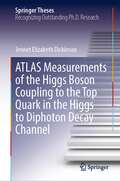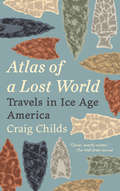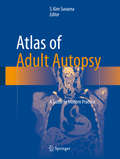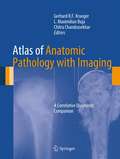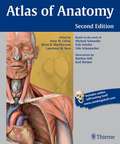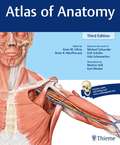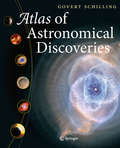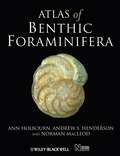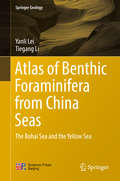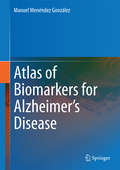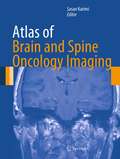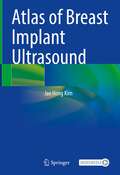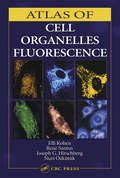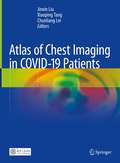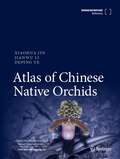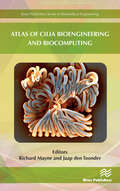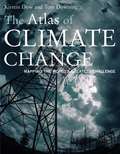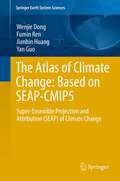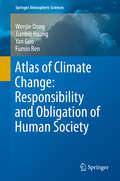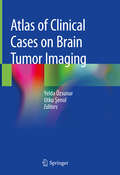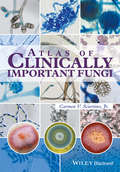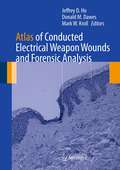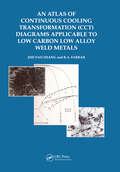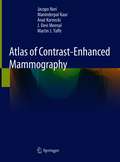- Table View
- List View
ATLAS Measurements of the Higgs Boson Coupling to the Top Quark in the Higgs to Diphoton Decay Channel (Springer Theses)
by Jennet Elizabeth DickinsonDuring Run 2 of the Large Hadron Collider, the ATLAS experiment recorded proton-proton collision events at 13 TeV, the highest energy ever achieved in a collider. Analysis of this dataset has provided new opportunities for precision measurements of the Higgs boson, including its interaction with the top quark. The Higgs-top coupling can be directly probed through the production of a Higgs boson in association with a top-antitop quark pair (ttH). The Higgs to diphoton decay channel is among the most sensitive for ttH measurements due to the excellent diphoton mass resolution of the ATLAS detector and the clean signature of this decay. Event selection criteria were developed using novel Machine Learning techniques to target ttH events, yielding a precise measurement of the ttH cross section in the diphoton channel and a 6.3 $\sigma$ observation of the ttH process in combination with other decay channels, as well as stringent limits on CP violation in the Higgs-top coupling.
Atlas of a Lost World: Travels in Ice Age America
by Craig ChildsFrom the author of Apocalyptic Planet comes a vivid travelogue through prehistory, that traces the arrival of the first people in North America at least twenty thousand years ago and the artifacts that tell of their lives and fates.In Atlas of a Lost World, Craig Childs upends our notions of where these people came from and who they were. How they got here, persevered, and ultimately thrived is a story that resonates from the Pleistocene to our modern era. The lower sea levels of the Ice Age exposed a vast land bridge between Asia and North America, but the land bridge was not the only way across. Different people arrived from different directions, and not all at the same time.The first explorers of the New World were few, their encampments fleeting. The continent they reached had no people but was inhabited by megafauna—mastodons, giant bears, mammoths, saber-toothed cats, five-hundred-pound panthers, enormous bison, and sloths that stood one story tall. The first people were hunters—Paleolithic spear points are still encrusted with the proteins of their prey—but they were wildly outnumbered and many would themselves have been prey to the much larger animals.Atlas of a Lost World chronicles the last millennia of the Ice Age, the violent oscillations and retreat of glaciers, the clues and traces that document the first encounters of early humans, and the animals whose presence governed the humans’ chances for survival. A blend of science and personal narrative reveals how much has changed since the time of mammoth hunters, and how little. Across unexplored landscapes yet to be peopled, readers will see the Ice Age, and their own age, in a whole new light.
Atlas of Adult Autopsy: A Guide to Modern Practice
by S. Kim SuvarnaThisatlas leads the reader through the adult autopsy process, and its commonvariations, with a large number of high-quality macroscopic photographs andconcise accompanying text. It provides a manual of current practice and is aneasy-to-use resource for case examination for consent, medico-legal andradiological autopsies. Externalrealities and checks are discussed at the beginning of the book, which goes onto cover specific body cavities and organ systems in detail. The book ends withchapters on topics including forensic autopsies, specialist sampling, toxicologyanalyses and the radiological autopsy. Atlasof Adult Autopsy is aimed at practicing pathologists, particularly those intraining grades. It may also be of interest to anatomical technicians inautopsy suites, as well as parties with a legal interest in autopsy practice.
Atlas of Anatomic Pathology with Imaging: A Correlative Diagnostic Companion
by Gerhard R Krueger L Maximilian Buja Chitra ChandrasekharAtlas of Anatomic Pathology with Imaging - A Correlative Diagnostic Companion is a valuable teaching tool for medical students and residents in several specialities such as pathology, radiology, internal medicine, surgery and neurologic sciences. Its need is all the more urgent given the severe shortcuts in the teaching of anatomic pathology following the decrease in the number of autopsies performed. Many of the images shown in the atlas would not be available without performing autopsies and therefore this atlas is an essential for all those in the field. Atlas of Anatomic Pathology with Imaging - A Correlative Diagnostic Companion is the first to combine gross anatomic pictures of diseases with diagnostic imaging. This unique collection of material consisting of over 2000 illustrations complied by experts from around the world is a valuable diagnostic resource for all medical professionals.
Atlas of Anatomy (2nd Edition)
by Anne M. Gilroy Brian R. Macpherson Lawrence M. Ross Michael Schünke Erik Schulte Udo SchumacherThis color illustrated reference for students of gross anatomy offers material in self-contained two-page spreads, illustrated with a total of 2,400 color anatomical illustrations and diagnostic images with call-out labels and captions noting clinical correlations. Material is presented in units on body regions: back, thorax, abdomen, pelvis and perineum, upper limb, lower limb, head and neck, and neuroanatomy. Each unit starts with surface anatomy, then represents bones, muscles, vasculature, and nerves, and closes with a topographical summary of the area. This second edition contains new sectional anatomy spreads at the end of each major unit; surface anatomy spreads now include region and reference lines. Some content has been reorganized to more closely parallel the progression and content of a typical dissection curriculum. Much of the artwork is new for this edition. The companion website contains labeled and unlabeled images from the book, plus timed self-tests. Annotation ©2012 Book News, Inc. , Portland, OR (booknews. com)
Atlas of Anatomy (Third Edition)
by Anne M. Gilroy Brian R. MacPherson Michael Schuenke Erik Schulte Udo SchumacherWith over 1,900 exquisitely detailed and accurate illustrations, the Atlas helps you master the details of human anatomy.
Atlas of Astronomical Discoveries
by Govert SchillingOffers a unique combination of informative text, magnificent illustrations and stylish design Examines the 100 most important discoveries since the invention of the telescope Features spectacular photographs, taken with the largest telescopes on Earth and in space, that portray distant corners of the universe Author Govert Schilling is a renowned astronomy journalist and science communicator In his Atlas of Astronomical Discoveries, astronomy journalist Govert Schilling tells the story of 400 years of telescopic astronomy. He looks at the 100 most important discoveries since the invention of the telescope. Doing what Schilling does best, he takes the reader on an adventure through both space and time. Photographs and amazing pictures line the pages of this book, offering the reader an escape from this world and an invitation to a world far beyond what the unaided human eye can detect.
Atlas of Benthic Foraminifera
by Ann Holbourn Andrew S. Henderson Norman MacleodAn up-to-date atlas of an important fossil and living group, with the Natural History Museum. Deep-sea benthic foraminifera have played a central role in biostratigraphic, paleoecological, and paleoceanographical research for over a century. These single–celled marine protists are important because of their geographic ubiquity, distinction morphologies and rapid evolutionary rates, their abundance and diversity deep–sea sediments, and because of their utility as indicators of environmental conditions both at and below the sediment–water interface. In addition, stable isotopic data obtained from deep–sea benthic foraminiferal tests provide paleoceanographers with environmental information that is proving to be of major significance in studies of global climatic change. This work collects together, for the first time, new morphological descriptions, taxonomic placements, stratigraphic occurrence data, geographical distribution summaries, and palaeoecological information, along with state-of-the-art colour photomicrographs (most taken in reflected light, just as you would see them using light microscopy), of 300 common deep-sea benthic foraminifera species spanning the interval from Jurassic - Recent. This volume is intended as a reference and research resource for post-graduate students in micropalaeontology, geological professionals (stratigraphers, paleontologists, paleoecologists, palaeoceanographers), taxonomists, and evolutionary (paleo)biologists.
Atlas of Benthic Foraminifera from China Seas: The Bohai Sea and the Yellow Sea (Springer Geology)
by Yanli Lei Tiegang LiThis atlas gives a comprehensive account on the benthic foraminiferal fauna in the China Seas, especially on the Bohai and the Yellow Seas. Details of about 183 species, subjected to 5 orders, 52 families and 92 genera are included. For each species there is a brief description of the morphological characteristics, synonymised names, measurements and geographical distribution worldwide, as well as a top-level elegant plate illustrated the fossil and live specimens. It could be used as a reference book for researchers working at marine biology, marine geology, micropaleontology, paleoceanography, paleobiology and related fields.
Atlas of Biomarkers for Alzheimer's Disease
by Manuel Menéndez GonzálezA lot of research on biomarkers for Alzheimer is being done in the last few decades. The aim of these studies is to find some method to ease the diagnosis of Alzheimers as early as possible. Such methods are a range of blood or CSF tests on one hand and several types of neuroimaging scans on the other. Many of the images coming both from laboratory and neuroimaging are very visual and illustrative. These images, accompanied by a short description, can perfectly explain the main results and usefulness of every biomarker. The objective of this book would be to summarize the most important studies made in this field. Few publications have systematically compiled results on this topic and only one as an atlas. Readers would be interested in this publication because it allows reviewing the current status of research by handily visualizing the results.
Atlas of Brain and Spine Oncology Imaging (Atlas of Oncology Imaging)
by Sasan KarimiAtlas of Brain and Spine Oncology Imaging presents a comprehensive visual review of pathologic disease variations of cancers of the brain and spine through extensive radiologic images. The focus of the book is on algorithmic strategies for identifying neoplastic pathologies commonly found in brain and spinal tumors through a visual representation of the variety of appearances that each neoplasm takes, within both benign and malignant manifestations. With contributions from radiologists on staff at a National Cancer Institute-designated comprehensive cancer center, who draw from an extensive collection of diagnostic images across all imaging modalities, this book will be valuable to practicing radiologists, radiation oncologists, surgeons and other practitioners involved in the diagnosis and treatment of brain and spinal neoplasms in all patient populations.
Atlas of Breast Implant Ultrasound
by Jae Hong KimThis atlas is the first book on the use of high-resolution ultrasound to assess breast implants and identify the various potential breast implant-related complications, which are frequently asymptomatic. The aim is to provide radiologists, breast surgeons, plastic surgeons, and other medical staff with a comprehensive guide of high clinical value during not only the diagnostic but also the treatment process. To this end, a wealth of ultrasound images and videos are presented, along with surgical photos and videos and pathological findings. The coverage includes the role of ultrasound in the management of breast implant-associated anaplastic large cell carcinoma, with explanation of its value in distinguishing the type of implant shell, which is highly relevant in this disease. A concluding chapter presents a large series of instructive cases. The author has extensive experience in breast surgery and has been collecting implant-related data using high-resolution ultrasound, including data on the diagnosis of side effects, for more than a decade.
An Atlas of Cat Anatomy
by Hazel E. Field Mary E. TaylorAn Atlas of Cat Anatomy can help a student learn twice as much as he could in the same amount of time using only a written description. The book is spiral bound and stands like an easel, taking a minimum amount of space in the work area. Altogether there are fifty-seven plates featuring the various parts and organ systems in their actual size, making identification remarkably easy. A brief verbal description accompanies each plate. In addition, the extensive glossary includes synonymous terms, derivations, definitions, and keys to pronunciation.
Atlas of Cell Organelles Fluorescence
by Elli Kohen Rene Santus Joseph G. Hirschberg Nuri OzkutukContaining over 150 original photomicrographs accompanied by protocol information, Atlas of Cell Organelles Fluorescence delineates organelles structures, interaction, and organization into complexes. It provides a collection that shows living cells under physiopathological conditions and in the context of treatment with carcinogens, xenobi
Atlas of Chest Imaging in COVID-19 Patients
by Jinxin Liu Xiaoping Tang Chunliang LeiThis book presents X-ray and CT findings of patients with 2019 Novel Coronavirus (2019-nCoV) pneumonia in early, progressive, critical, and recover stage. It starts with a general review of CT features of new coronavirus pneumonia. In the following chapters, imaging manifestations in different groups and stages are presented, especially CT findings of asymptomatic COVID-19 patients and those first nucleic tests for the novel coronavirus are negative, but turn positive in one day or two. In addition, imaging and pathological analysis of COVID-19 death are summarized in the last chapter. The book provides a valuable reference source for radiologists and doctors working in the area of coronavirus pneumonia.
Atlas of Chinese Native Orchids
by Xiaohua Jin Jianwu Li Deping YeThis book updates taxonomy information of orchids in China. China is one of the countries with the richest biodiversity. In China, all five subfamilies of Orchidaceae are represented, about 1600 orchid species in 198 genera. All orchids are rare and endangered plants. They are among the flagships for biological conservation, listed in CITES appendix I or II. This book provided an updated classification system of Orchidaceae with newly recorded and published species in China and new combinations. 1026 species in 157 genera of native species in China are included, about half of which are newly recorded or published species in China in the last two decades. Indexes to genera and species are included. For each species, one to four photos, most of which were taken by the authors, are utilized to illustrate habitats, morphological characters, and phenology. Furthermore, the geographic distribution of them also demonstrated in a map. This book can be used as a reference for researchers working on Orchidaceae, as well as practitioners in the horticulture community.
Atlas of Cilia Bioengineering and Biocomputing
by Richard Mayne Jaap Den ToonderCilia are microscopic finger-like cell-surface organelles possessed by a great many eukaryotic organisms, including humans, whose purposes include generating local fluid movements via rhythmic whip-like beating and environmental sensing. Despite intense research efforts since their discovery by van Leeuwenhoek in the 1670's, several key questions regarding ciliary functions, experimental manipulation and in silico imitation remain unanswered. Major justifications for cilia research lie in their involvement in various forms of human disease (ciliopathies) and their ability to instantiate decentralised, asynchronous sensorial-actuation of adjacent matter through modulation of beating characteristics. Further elucidation of these characteristics, which is a problem requiring the combined expertise of mathematicians, computer scientists, engineers and life scientists, will lead to novel biomedical therapies, creation of `smart' actuating surfaces for microfluidics/lab-on-chip applications and a greater understanding of fluid mechanics in real-world scenarios. This lavishly-illustrated anthology presents recent advances in the fields of ciliary investigation, manipulation, emulation, mimesis and modelling from key researchers in their fields: its goal is to explain the state-of-the-art in cilia bioengineering and bio-computation in a uniquely creative, accessible manner, towards encouraging further transdisciplinary work in the field as well as educating a broad spectrum of scientists and lay people. The volume is split into three distinct but interwoven themes:Biology: Biological preliminaries for the study of cilia; the state-of-the-art in genetic engineering of ciliated cells for biomedical purposes; reprogramming of cilia dynamics in live cells.Engineering: Creation of macro cilia robots for object sorting applications; pneumatic cilia for the optimization of fluid motion; electrostatic, magnetic and MEMS cilia for microfluidic mixing; reviews in artificial cilia fabrication, actuation and flow induction methods.Numerical and computational modelling. Analyses of thin film cilia for `lab on chip' microfluidic mixing applications; modelling of gel-based artificial cilia towards simulating dynamic behaviors of responsive cilia layers in complex fluids across a wide range of potential applications.
The Atlas of Climate Change: Mapping the World's Greatest Challenge
by Kirstin Dow Thomas E. DowningThis is an essential resource for policy makers, environmentalists, students, and everyone concerned with this pressing subject.
The Atlas of Climate Change: Based on SEAP-CMIP5
by Fumin Ren Jianbin Huang Wenjie Dong Yan Guo"The Atlas of Climate Change--Based on SEAP-CMIP5" is intended to satisfy readers' curiosity: how will our climate system change over the next 100 years? It is the first showcase for the state-of -the-art earth system models that released their CMIP5 simulations for the IPCC AR5.The atlas focuses on both the past climate system change from 1850 and the projection of the future climate system change to 2100 using the RCP2.6, RCP4.5 and RCP8.5 scenarios based on climate models. This provides the research and application community interested in the impact of climate change on fields such as agriculture, ecosystem, environment,water resources, energy, health, economy, risk governance and international negotiation, etc. with the newest climate change projection information. Additionally, the atlas will show the historical responsibility of the developed/developing countries and possible contributions to the mitigation of climate change according to their pledge of GHG emission reduction after the Cancun Agreement as an extension numerical experiment to CMIP5 with NCAR's CESM1.0. The authors will update this atlas after future releases of CMIP5 model outputs and update the figures in the second edition of the atlas in 2012-2013. Both Prof. Wenjie Dong and Yan Guo work at the Beijing Normal University, China. Prof. Fumin Ren works at the China Meteorological Administration, China. Prof. Jianbin Huang works at the Tsinghua University, China.
Atlas of Climate Change: Responsibility and Obligation of Human Society (Springer Atmospheric Sciences)
by Fumin Ren Jianbin Huang Wenjie Dong Yan GuoThis atlas and reference resource assembles the latest research findings on the responsibility and obligation of human society for historical climate change. It clearly and quantitatively estimates to what extent the developed and developing world are responsible for historical climate change with regard to anthropogenic carbon and sulfur emissions as well as global carbon trade, and so provides a potential tool to address the controversial issue of carbon emission reduction in international climate negotiations. Since the quantitative attribution of historical climate change is calculated based on CMIP5 models, the fidelity of these models in representing the observed climate change is also evaluated. In addition to evaluation, future climate change based on CMIP5 models is also shown both on global and regional scales (especially for China and its surrounding areas ) in terms of surface air temperature, precipitation, sea surface temperature, atmospheric circulations and Arctic Sea ice. The atlas also makes various comparisons among different multi-model ensemble methods in order to obtain the most reliable estimation.
Atlas of Clinical Cases on Brain Tumor Imaging
by Yelda Özsunar Utku ŞenolThis book presents and analyzes clinical cases of brain tumors and follows the classification provided by the WHO in 2016. After introductory chapters reviewing the international literature on the topic, the advances made in all imaging modalities (especially Magnetic Resonance and Computed Tomography) are examined.All radiological findings are supplemented with a wealth of images and brief explanations. The clinical information is given as part of the case discussion, as are the characteristics and differential diagnosis of the tumors. Radiologic-pathologic correlations round out the description of each clinical case.Intended as a quick and illustrative reference guide for radiology residents and medical students, this atlas represents the most up-to-date, practice-oriented reference book in the field of Brain Tumor Imaging.
Atlas of Clinically Important Fungi
by Carmen V. Sciortino Jr.Although there are many texts that provide quality information for the identification of fungi, researchers and technologists rarely have time to read the text. Most are rushed for time and seek morphological information that helps guide them to the identification of fungi. The Atlas of Clinically Important Fungi provides readers with an alphabetical list of fungi as well as listing the division of fungi by both sporulation and morphology. The characteristic traits for a particular fungus are displayed through a series of images, with the fungi appearing as they did in the author's lab on the day(s) that testing was performed. For this reason, numerous (6-20) color photographs are included so that technologists will have sufficient reference photos for identifying the various morphologies of a single organism. Organism photographs begin with the macroscopic colony views followed by the microscopic views. Also included for some microorganisms, are clinical pathology photographs demonstrating how the organism appears in human tissues.A collection of literature citations are also provided to enable further reading. This user-friendly fungi atlas provides a resource for those seeking information in the field of medical mycology, specifically with regards to identifying an organism using the parameters of culture morphology.
Atlas of Conducted Electrical Weapon Wounds and Forensic Analysis
by Jeffrey D. Ho Mark W. Kroll Donald M. DawesAtlas of Conducted Electrical Weapon Wounds and Forensic Analysis provides a comprehensive publication on the subject of Conducted Electrical Weapon (CEW) wounds and signature markings created by this class of weapon. This volume will serve as a very useful resource for all professions tasked with assisting persons that have allegedly been subjected to a CEW exposure. The volume provides an introduction to basic CEW technology and the types of CEWs currently available. It also serves as a comprehensive pictorial atlas of signature markings that CEW exposures make in the immediate and more remote post-exposure periods. Also, it discusses the ability of forensic specialty examinations of the CEW itself to aid in the determination of whether the alleged CEW exposure is consistent with the objective evidence and the subjective statements. Finally, this text addresses the important and growing area of factitious CEW markings that will be useful for consideration by investigators and litigators. Atlas of Conducted Electrical Weapon Wounds and Forensic Analysis provides an objective atlas of evidence for reference that will benefit those professionals who often must make diagnostic, treatment or legal judgments on these cases including Emergency and Primary-Care Physicians, Medical Examiners, Forensic Pathologists, Coroners, Law Enforcement Investigators, and Attorneys.
An Atlas of Continuous Cooling Transformation (CCT) Diagrams Applicable to Low Carbon Low Alloy Weld Metals
by Zhuyo ZhangThis atlas is a collection of continuous cooling transformation diagrams applicable to low carbon low alloy weld metals. It will be of assistance to welding engineers, welding metallurgists, welding-consumables designers in industry.
Atlas of Contrast-Enhanced Mammography
by Jacopo Nori Maninderpal Kaur Anat Kornecki J. Devi Meenal Martin J. YaffeThis superbly illustrated atlas serves as a basic introduction to contrast-enhanced mammography (CEM), a breakthrough functional breast imaging modality, which is rapidly growing. This book is an essential guide for the latest developments with correlative findings, practical interpretation tips, physics, and information on how contrast mammography differs from conventional 2D and 3D Full Field of View digital mammography (FFDM). It includes: · over 1000 high-quality 2D, 3D and recombined contrast mammography images representing the spectrum of breast imaging · findings obtained in the full range of benign, pre-malignant and malignant conditions, including artefacts and postoperative changes, presented with high-quality illustrations from case examples · image interpretation tips using mammographic and DCE-MRI descriptors of the BI-RADS lexicon to effectively read and interpret this advanced imaging modality · practical tips to interpret this new modality and how it is used as an adjunct to 2D mammography · details on how integration of contrast-enhanced mammography drastically changes lesion work-up and overall workflow in the department · "imaging pearls" boxes offering interpretation tips for expert clinical guidance · a case on the recently introduced CEM guided biopsy procedure The book’s target audience consists of diagnostic radiologists, residents, fellows, technologists and clinicians involved in the care of breast cancer patients, including surgeons and oncologists. The goal is to provide a concise introduction to CEM and to lead to enhanced interpretation and better patient staging prior to surgery.
